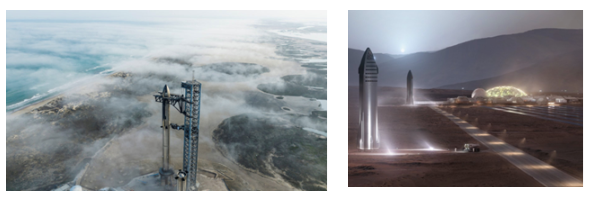Starship: A Leap into Spacefaring
- Tomás Woods
- May 28, 2023
- 3 min read

View of starship in Boca Chica Texas Starships on Mars artist interpretation
Starship, went through its first ever flight test just some weeks ago on April 20th, and despite not having reached orbit properly it has proven its capabilities to the world. The rockets we see in comic books and sci-fi movies have finally been built under the name of Starship. This is the world’s most powerful rocket and here’s what qualifies it to being humanities spacefaring vehicle in an interplanetary future.
For centuries, humans have been driven by the thirst for exploration, perception and the curiosity to know our place in the universe. Whether that came from the the first deep sea submarine or the discovery of the steam engine we have always invented machines to explore above and beyond. Today, SpaceX is reviving our instinct for space exploration, to orbit, moon and mars. As a line of clear curvature, our pursuit to reach the stars was facing a decline, from the halting of the Apollo programme in the 1970s to the last space shuttle, we were facing an undeniable end. That is until, on the 14th of March 2002, Space Exploration Technologies Corporation, SpaceX was founded. It tilted the incline with its Falcon 9 success missions and re-established US’s domain of the industry. Its cost-efficient rockets have shown that just like planes, they can be reused and landed on a platform whether on land, or ashore. As the company faithfully builds on to reaching its foundation aim of fostering a spacefaring civilisation, machines such as the development of the FBR, known today as Starship arise.
The 1st stage of the rocket, standing 120 meters tall and 9 meters wide is powered by 33 v2 raptor engines releasing over 16 million pounds of thrust or more than twice that of Saturn V. Never, has a rocket been fitted with that many engines and never would it be intended to land on the exact place it was launched from. For that much power, 10 million pounds of liquid propellant is loaded up, which is equivalent to filling the tank of over 20,000 cars. 4 waffle-shaped titanium gridfins the size of a minivan guide the rocket through the entry burn where it performs a flip maneuver to position it for descent. It lands softly, and after some refurbishment it is ready to be reused, much like Falcon 9 (or so is intended). But why so many engines? It comes down to prevention, if one of the engines malfunction, the entire rocket won’t fall from the sky. According to some industry analysts such as Phil Smith from BryceTech, despite the upsides of mounting 33 boosters “(…) operationally it has not been proven.”. Nonetheless, significant progress over the past 5 years have demonstrated its potential to function as the best heavy lift booster in the world.
The 2nd stage of the rocket, the “starship” is also a fully reusable craft capable of loading between 100-150 tons of cargo. Alternatively, it will also be cable of carrying a crew of over 100 passengers to deep space exploration missions. This is key to the future of martian colonization in case this isn’t wishful thinking.
In conclusion, with over two decades of development CEO Elon Musk has overseen his company that strove to do nothing but the most challenging engineering craftwork, perhaps in human history. Since the end of the Egyptian or Roman Empire, this is most probably the finest revolution in colonization and the most daring adventure in safeguarding human consciousness.






コメント